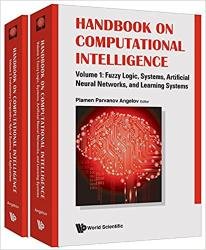 Название: Handbook on Computational Intelligence (In 2 Volumes)
Название: Handbook on Computational Intelligence (In 2 Volumes)Автор: Plamen Parvanov Angelov
Издательство: World Scientific Publishing
Серия: Series on Computational Intelligence
Год: 2016
Страниц: 957
Язык: английский
Формат: pdf, epub
Размер: 30.5 MB
With the Internet, the proliferation of Big Data, and autonomous systems, mankind has entered into an era of 'digital obesity'. In this century, Computational Intelligence (CI), such as thinking machines, have been brought forth to process complex human problems in a wide scope of areas - from social sciences, economics and biology, medicine and social networks, to cyber security. The Handbook of Computational Intelligence (in two volumes) prompts readers to look at these problems from a non-traditional angle. It takes a step by step approach, supported by case studies, to explore the issues that have arisen in the process. The Handbook covers many classic paradigms, as well as recent achievements and future promising developments to solve some of these very complex problems. Volume one explores the subjects of fuzzy logic and systems, artificial neural networks (ANNs), and learning systems. Volume two delves into evolutionary computation, hybrid systems, as well as the applications of Computational Intelligence in decision making, the process industry, robotics, and autonomous systems. This work is a ""one-stop-shop"" for beginners, as well as an inspirational source for more advanced researchers. It is a useful resource for lecturers and learners alike.
However, Artificial Intelligence (AI) is nowadays rather linked with logic, cognition, Natural Language Processing (NLP), induction and so on, while Computational Intelligence (CI) has been developed in a direction that can be described as “nature-inspired” alternatives to the conventional/traditional computing approaches. This includes, but is not limited to:
- Fuzzy logic (as a more human-oriented approach to reasoning);
- Artificial neural networks (mimicking the human brain);
- Evolutionary algorithms (mimicking the population-based genetic evolution), and
- Dynamically evolving systems based on the above.
Some authors also attribute other areas of research such as belief-based Depmster–Shafer theory, chaos theory, swarm and collective intelligence, etc. on the margins of Computational Intelligence. It is also often the case that the application areas such as pattern recognition, image processing, business and video analytics and so on are also attributed or linked closely to Computational Intelligence; areas of research that are closer to Statistical Learning (e.g., Support Vector Machines), probability theory, Bayesian, Markov models etc. are also sometimes considered to be a part of Computational Intelligence.
In this handbook, while not closing the door to all possible methods and alternatives, we keep clear the picture of Computational Intelligence as a distinct area of research that is based on the above mentioned pillars and we assume that the other areas are either applications of Computational Intelligence methods, techniques or approaches or research areas that gravitate around Statistical Learning.
The primary goal of the area of Computational Intelligence is to provide efficient computational solutions to the existing open problems from theoretical and application points of view in understanding, representation, modeling, visualization, reasoning, decision, prediction, classification, analysis and control of physical objects, environmental or social processes and phenomena to which the traditional methods, techniques and theories (primarily, so-called “first principles”, deterministic, often expressed as differential equations and stemming from mass-and energy-balance) cannot provide a valid or useful/practical solution.
Another specific feature of Computational Intelligence is that it offers solutions that bear characteristics of “intelligence” which is usually attributed to humans only. This has to be considered broadly rather than literally as in the area of “artificial intelligence”. For example, fuzzy logic systems can make decisions like humans do. This is in a stark contrast with the deterministic type expert systems as well as with the probabilistic associative rules. For artificial neural networks, one can argue that they process the data in a manner which is more like what human Brain does.
In 2 Volumes:
Volume 1: Fuzzy Logic, Systems, Artifical Neural Networks, and Learning Systems
Volume 2: Evolutionary Computation, Hybrid Systems, and Applications
Скачать Handbook on Computational Intelligence (In 2 Volumes)